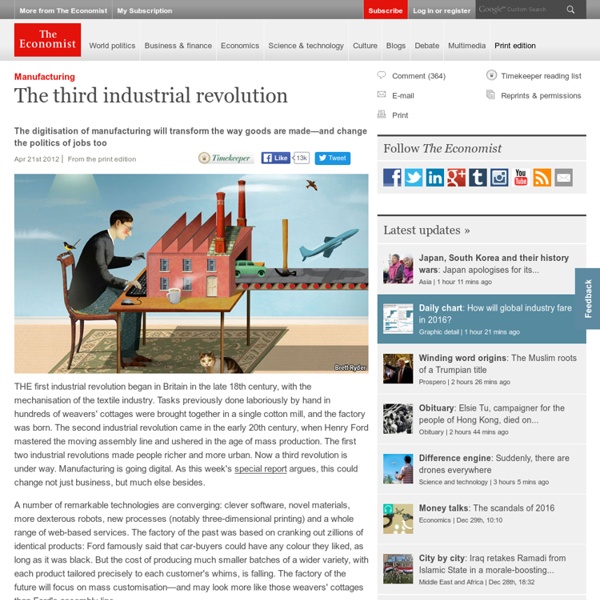Manufacturing: The third industrial revolution

http://www.economist.com/node/21553017
Pebble: E-Paper Watch for iPhone and Android by Pebble Technology
Want your watch to tell you when your next bus is leaving? Maybe you're jonesing to see your compile status or recent github commits.. Think push notifications, directly to your watch using the data connection on your phone.
DIY smart materials
Untitled
Why Lean Canvas? — www.ashmaurya.com
454 Flares242065945120--×454 Flares x Access to videos, talks, and worksheetsInvitation to private Google Plus CommunityJoin in on live Q&A webinars and fireside chats
Portal líder de la impresión 3D en español
The Facebook IPO – US Business News — Carly Fiorina: An Open Letter to Mark Zuckerberg
Do not establish the precedent of providing quarterly earnings guidance. While you must of course protect competitively sensitive information, communicate as proactively and transparently as possible about your strategic goals and operational performance metrics as well as how you track your own progress and performance against both. 2) Whatever the ultimate valuation of Facebook, it will be one of the most sought after equities in the world.
Google usa deficiente visual para testar carro com piloto automático
O Google usou um motorista com deficiência visual para testar o funcionamento de seu automóvel com piloto automático, informou nesta quarta-feira (28) a companhia, que publicou um vídeo no YouTube com a experiência. Assista ao vídeo. Steve Mahan ocupa o lado do motorista, mas não usa as mãos, nem o pés, para pilotar o carro. (Foto: Reprodução / YouTube / Google) A gravação intitulada "Self-driving car teste: Steve Mahan" mostra a viagem de Steve Mahan, um homem com incapacidade visual de 95%, em um percurso por sua cidade a bordo de um Toyota Prius equipado com a tecnologia do Google para autocondução. "Estou muito acima do que se considera estar legalmente cego", comenta Mahan nas imagens, nas quais explica como a perda da visão lhe impede de fazer coisas que antes podia realizar e o papel que poderia representar um automóvel como o da Google em seu dia a dia.
Building Businesses That Stand For Something
Last year, Patagonia launched a “Don’t Buy This Jacket” campaign, encouraging people to buy their products used instead of new. Yvonne Choiunard, the founder of Patagonia, was a climber, and realized the natural resources it took to produce new products would limit the potential of his business in the long run, which relies on preserving the outdoors as a place for people to play. The company changed their materials and started building durable, longer lasting products, only encouraging sales if used pieces couldn’t be found. Aligning customers’ values with their own will prove much more important in the long run than the bottom-line sale of coats.
Related:


